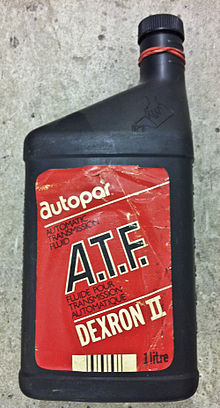Dexron

Dexron is a registered trademark and set of technical specifications for automatic transmission fluids (ATF) created by General Motors (GM) and manufactured and sold by other manufacturers under license.
Initially, Dexron only referred to automatic transmission oils, later GM also specified transmission oils under this name.
Automatic transmission oils
The original Dexron automatic transmission fluid was introduced in 1968. Over the years the term Dexron has been expanded to include the specifications Dexron-II , Dexron-IIE , Dexron-III , and Dexron-VI . GM had revised the specifications over time so that the newer oils were not necessarily backwards compatible with older ones. So Dexron-IV was never marketed because the requirements were met by previous standards.
Dexron
In the first Dexron oil, like its predecessor Type-A / Suffix-A , whale oil was used as a friction additive to change the friction properties . The Endangered Species Act , which the United States Congress to species protection adopted, banned the import of whale oil, the oil be changed and the composition had.
Dexron-II, IID and IIE
Dexron-II was introduced in 1972. It used friction additives like jojoba oil . After the oil caused corrosion problems at the soldered joints of GM oil coolers, corrosion inhibitors were added to the oil . The resulting product was specified as Dexron-IID in 1975 . After it was recognized that the corrosion inhibitors made the oil hygroscopic , which was not a major problem in automatic transmissions , but made Dexron-IID oil unattractive for use in other hydraulic systems that had previously adopted it, it had to be touched up again. The further developed oil with reduced hygroscopic properties got the specification Dexron-IIE , at GM: GM6137M .
Dexron-III, IIIG and IIIH
In 1993, GM published the Dexron-III oil specification, internal specification: GM6417M , later GMN10055 . Dexron-III is backwards compatible with earlier oils with the Dexron specification and its predecessor Type-A / Suffix-A . Licensed oil manufacturers usually code the corresponding products with DX III or DX-III .
- Dexron-IIIG
The Dexron-IIIG specification has been optimized for rotary compressors that operate at low temperatures, as well as power steering and transmissions from GM and Ford manufactured after 1997.
- Dexron IIIH
Dexron-IIIH appeared in 2003 and replaced Dexron-IIIG with improved friction additives, oxidation inhibitors , defoamers , and more durable base oil.
- Dexron-IV
Is the specification for an oil that never existed. The efforts to introduce this further developed standard were not fully accepted by GM's management and work on it was discontinued. As a result, there were minor improvements to the existing Dexron-III specification .
Dexron VI
The specification for Dexron-VI was issued in 2005 but was not used until 2006 in GM's factories as the first fill of automatic transmissions. All licenses on Dexron-III were permanently withdrawn at the end of 2006 and since then GM has only supported oils with Dexron-VI specification for use in automatic transmissions. Some manufacturers claim their oils continue to meet the Dexron-III standard but continue to sell them under names such as Dex or Merc . These oils are not endorsed or regulated by GM.
In its new condition, Dexron-VI has a maximum of 6.4 cSt at 100 ° C, a significantly lower viscosity than previous Dexron oils. Dexron III is 7.5 cSt. The loss of viscosity due to shear that occurs on the automatic transmission oil during operation is lower with Dexron VI , since the lowest specified permissible value is 5.5 cSt and which Dexron III and VI share identically. The specification of the lower viscosity is due to the requirements of lower fuel consumption . This reduces parasitic friction in the automatic transmissions. Since the specification Dexron VI prohibits more thinning (drop in viscosity) than is still permitted with Dexron III within the service life, this requires more stable base oils (base oils) with better resistance to shear. The specification GMW16444 , which defines this, replaced the specification GMN10060 .
Web links
- GM Rolls Out Dexron VI ( Memento from November 18, 2013 in the Internet Archive ) (GM introduces Dexron VI )
- GM Launches More Fuel-Saving Six-Speed Automatic Transmissions ( Memento from December 14, 2008 in the Internet Archive )
- GM Dexron ™ website
Individual evidence
- ^ Biochemicals for the Automotive Industry. (PDF) Retrieved December 27, 2013 .
- ^ A b Richard Michell: Which Oil ?: Choosing the Right Oil and Grease for Your Antique, Vintage, Veteran, Classic or Collector Car. ( books.google.com ).
- ↑ General Motors Dexron-IV Global Service Fill Specification. (No longer available online.) Webcitation.org, archived from the original on November 9, 2011 ; Retrieved December 27, 2013 . Info: The archive link was inserted automatically and has not yet been checked. Please check the original and archive link according to the instructions and then remove this notice.
- ↑ a b Lube Report: GM Rolls Out Dexron-IV. (No longer available online.) Webcitation.org, archived from the original January 28, 2013 ; Retrieved December 27, 2013 . Info: The archive link was inserted automatically and has not yet been checked. Please check the original and archive link according to the instructions and then remove this notice.
- ↑ Redline Oil product description of D6 ATF. Webcitation.org, accessed December 27, 2013 .